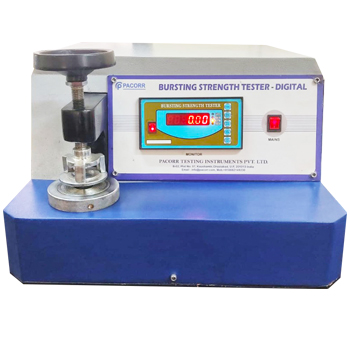Introduction
Bursting strength tester testing is a critical quality control measure, but like any testing procedure, it can face challenges. This guide delves into common issues encountered during bursting strength testing and provides troubleshooting solutions to ensure accurate and reliable results.
I. Inconsistent Results
Problem: Variations in bursting strength measurements between tests on the same material.
Possible Causes and Solutions:
-
Sample Preparation:
- Cause: Irregularities in sample size or shape.
- Solution: Ensure samples are cut precisely and uniformly to eliminate discrepancies.
-
Fixture Alignment:
- Cause: Misalignment of the sample in the testing machine.
- Solution: Carefully align samples in the machine to ensure uniform force distribution.
-
Machine Calibration:
- Cause: Incorrect calibration or calibration drift.
- Solution: Regularly calibrate the testing machine to maintain accuracy.
II. Premature Rupture
Problem: The sample ruptures before reaching the expected bursting strength.
Possible Causes and Solutions:
-
Excessive Pressure Application:
- Cause: Too much pressure applied too quickly.
- Solution: Adjust the testing parameters to apply pressure gradually, ensuring controlled loading.
-
Material Weakness or Defects:
- Cause: Inherent weaknesses or defects in the material.
- Solution: Inspect materials for defects before testing and consider using higher-quality samples.
III. Sample Slippage
Problem: The sample slips or shifts within the testing machine during the test.
Possible Causes and Solutions:
-
Inadequate Fixturing:
- Cause: Insufficient clamping or fixturing of the sample.
- Solution: Securely clamp the sample to prevent movement during testing.
-
Material Properties:
- Cause: Low-friction materials may be prone to slippage.
- Solution: Use additional fixtures or grips designed for low-friction materials.
IV. Inaccurate Data Recording
Problem: Incorrect or inconsistent data recording during the test.
Possible Causes and Solutions:
-
Human Error:
- Cause: Operator error in recording data.
- Solution: Provide thorough training to operators and implement double-check procedures.
-
Software or Instrument Malfunction:
- Cause: Software glitches or instrument malfunctions.
- Solution: Regularly inspect and maintain testing equipment, and update software as needed.
V. Environmental Factors
Problem: Fluctuations in environmental conditions affecting test results.
Possible Causes and Solutions:
- Temperature and Humidity:
- Cause: Variations in temperature and humidity levels.
- Solution: Conduct tests in a controlled environment and monitor conditions for consistency.
VI. Compliance with Standards
Problem: Non-compliance with industry-specific standards.
Possible Causes and Solutions:
- Inadequate Adherence to Standards:
- Cause: Failure to follow industry-specific protocols.
- Solution: Ensure that testing procedures align with relevant standards and protocols.
Conclusion
Addressing common issues in bursting strength testing requires a combination of meticulous sample preparation, proper equipment maintenance, and adherence to industry standards. Troubleshooting effectively ensures accurate and reliable results, enhancing the overall quality control process.


